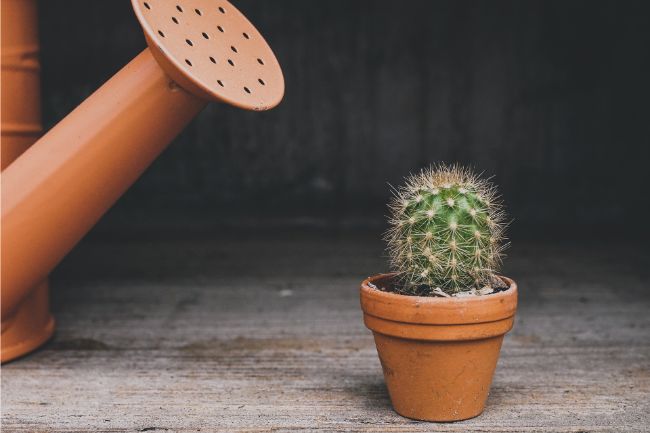If you are looking for a low maintenance houseplant and a cactus has caught your eye, you are in for an absolute treat. Cactus plants make fantastic houseplants and are generally easy to care for. The one thing that can be challenging with cactus care is knowing how often to water cactus plants, as it is so easy to be over-enthusiastic with the watering can.
How often to water a cactus? Most cactus should be watered once the soil has completely dried out. Don’t water on a schedule, but monitor the condition of the plant and dryness of the potting mix to know when to water a cactus. Factors such as size of cactus, size of pot, temperature, humidity and season will all affect how often to water cactus plants.
Understanding the water requirements of your cactus is important. Cacti are succulents and are designed to store water in their roots and stems, to help them survive periods of drought. While each cactus has different water requirements, there are a number of techniques you can use to make sure you always know when to water your cactus.
How Often To Water Cactus Plants Indoors
Most people have the misconception that cacti only need a few sips of water here and there, and while it is true that they are drought-resistant, they most definitely need a regular supply of water.
In fact, they thrive when they are watered sufficiently. Cacti tend to do best when they are watered thoroughly, and then left until the potting media has dried fully before being watered again.
There are many factors which can affect how quickly the potting media will dry out, and as a result, how often to water your cactus plants.
Here are 9 of the top factors that influence how often to water cactus plants.
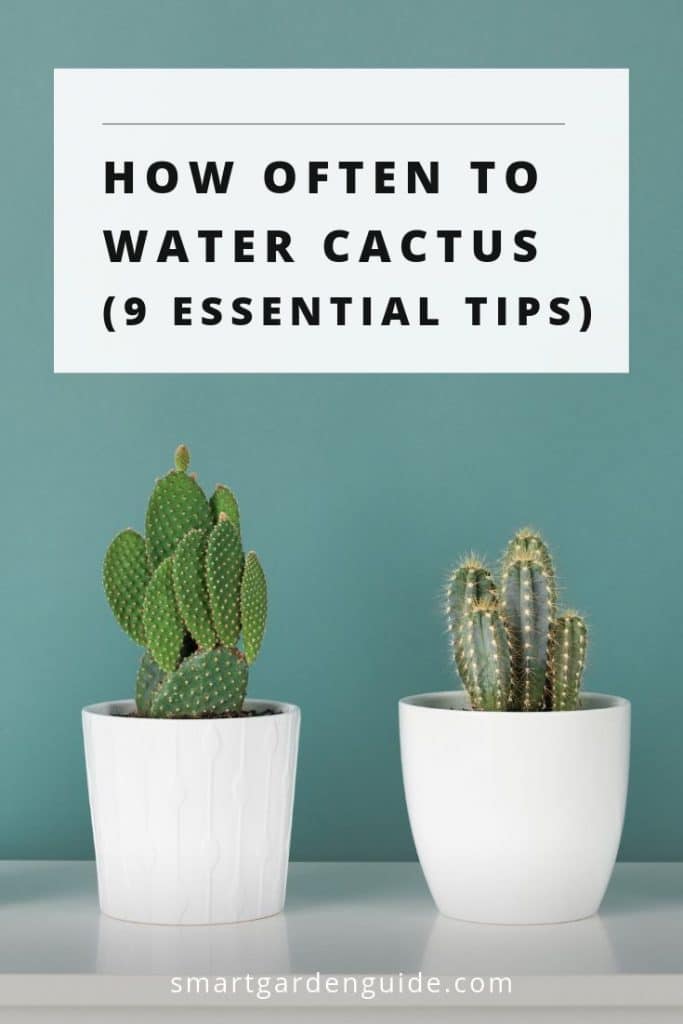
1. Size Of Cactus
You might assume that the larger a cactus is, that the more frequently it will need watered. However, younger, smaller cacti typically have higher growth rates and will require and use more water in relation to their size.
Larger cacti also have a a smaller surface area to volume ratio, which will decrease evaporation of water from the surface of the cactus. Typically, you will need to provide substantially more water to a larger cactus when you do water it, but you may find that smaller, faster growing cacti, planted in smaller pots actually require closer attention and more frequent watering.
2. Size Of Pot Affects How Often To Water A Cactus
Large pots contain more potting medium and it takes longer for a cactus to absorb the water in the potting medium, or for the water to drain or evaporate.
Larger pots also have smaller surface area to volume ratios. As a result, a cactus planted in a large pot may only need watered every 4-6 weeks or more, whilst a cactus planted in a very small pot may need to be watered once a week or less.
Most cacti do better in smaller pots, as they don’t like sitting in water for too long. It can be really difficult to avoid root rot if you have a cactus planted in an oversized pot, so if you are having problems, repot your cactus into a pot that is just large enough for the cactus and no more
3. Type Of Pot And Drainage
For cacti, the best strategy is to provide a lot of water and then have the excess drain rapidly and the potting media dry quite quickly. Plastic pots will trap moisture, increasing the time it takes for the potting media to dry out.
Terracotta pots are porous and the water in the potting media will slowly pass through the walls of the pot and evaporate into the air, dramatically reducing the time it take for the potting media to dry out.
Similarly, pots with plenty of drainage holes are much better, as these allow the excess water in the potting media to drain out of the pot rapidly. Trying to grow cacti in pots without holes is generally a miserable experience. It can be done, but is much more likely to lead to root and stem rot. I speak from bitter experience!
4. Type Of Potting Media
For success with growing cacti, you should ensure the potting medium is fast draining. Any commercial cactus mix will do, or a DIY combination of potting soil, coarse sand and perlite will do a great job. A well draining mix will allow excess water to drain easily and allow the soil to dry quickly. Obviously, this will mean you will need to water more frequently, but your cactus will thank you for it.
5. Ambient Temperature And Airflow Impact How Often To Water Cactus Plants
Warmer temperatures lead to increased evaporation from your cactus and from the soil surface. Higher temperatures also usually mean the plant will be actively growing and will be using more water.
During the cooler winter months, when your cactus isn’t growing much, you may only have to water the plant every 4-6 weeks, but during hot summer months, with the plant putting on growth, you may need to monitor the dryness of the potting mix every few days.
The great thing about cacti is they will tolerate being underwatered really well. So if you’re a bit slow with the watering can, the cacti won’t suffer too much, but being over-enthusiastic is where all the problems start.
In addition to temperature, increased airflow increases evaporation. Bear this in mind, particularly if you move your cactus outside in the summer, where ventilation will be much higher and water requirements will increase significantly.
6. Humidity Impacts How Often To Water Cacti
Evaporation levels will be higher is arid conditions. Wet potting mix will dry much faster as the air will have plenty of capacity to take up more water.
Keeping an eye on the humidity levels is generally a good idea when caring for most indoor plants and can help you to predict water requirements. Cacti do much better in arid conditions, but even in a humid interior, as long as you monitor soil dryness, you can still have great success.
7. Light Conditions
Direct sunlight will increase the rate of evaporation and the speed at which your cactus soil dries out. If kept in a south facing window, you will need to water your cactus much more frequently, compared to a cooler north facing room.
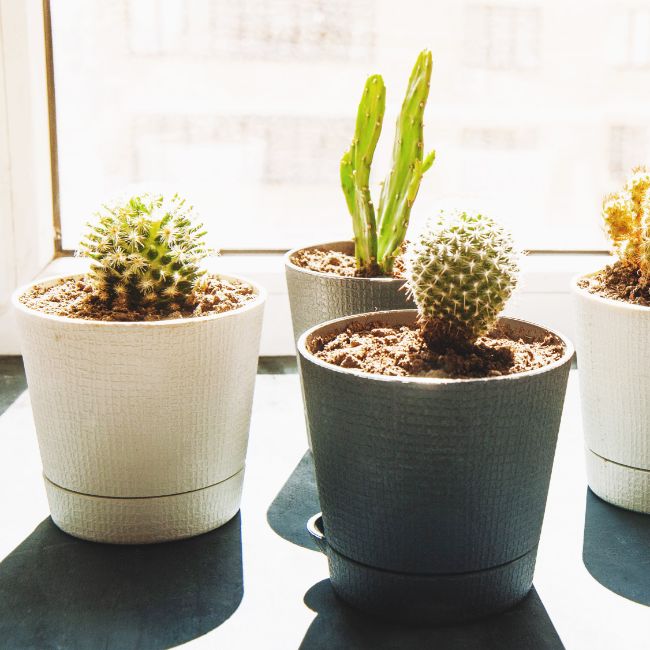
8. The Species Affects How Often To Water A Cactus
Every plant has its own watering requirements and it is much the same with cacti. The type of cactus that you choose to grow at home will determine will impact how often you need to water it. Some Cacti like a bit more water than others and you should refer to the specific species for advice about how often to water your cactus.
9. The Time Of Year Will Affect Water Requirements Of Cactus Plants
During summer and the active growing season, Cacti need frequent watering. Cacti typically need less water during the colder, dormant months of winter. You can cut back watering by at least half or even more during this time.
I’ve got another article which goes really well with this one about how much water to give your cactus when you water it. It’s really helpful to know about how cacti respond to water in their natural environment and this can help you to get watering right every time.
How To Tell If Your Cactus Potting Mix Is Dry
There is a fairly easy way to determine when your Cactus needs water, regardless of the season. As a general rule of thumb, the soil should completely dry out between watering.
But how to check the soil at the bottom of the pot for dryness?
There are a few options.
- Poke a finger into one of the drainage holes at the bottom to feel for moisture.
- Push a stick or skewer gently into the potting mix to the bottom. Leave it for a few seconds before removing it. If the stick looks or feels damp, you know to leave it a while longer before watering.
- Use your finger to poke into the top few inches of potting mix. If the soil feels dry right the way down, you can add water. If the soil is wet and clings to your finger, you can wait a while longer for it to dry out some more.
How To Water Cactus Plants Indoors
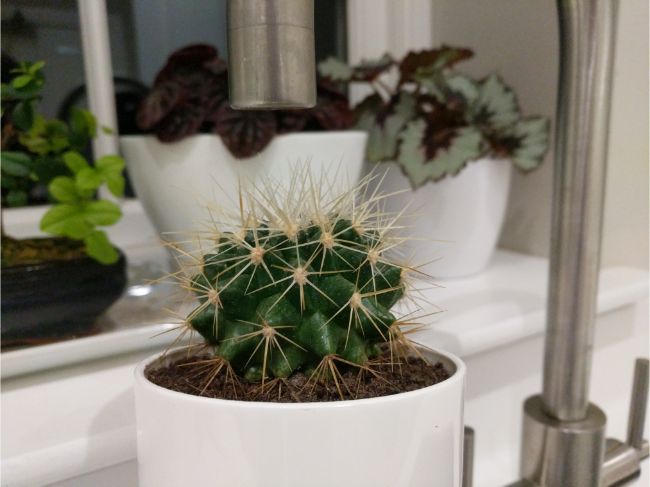
Once houseplant owners know that their Cactus needs watering, they are often unsure about how much water the plant requires.
When you water your cactus, make sure that you give it a decent soaking until the water runs out of the drainage holes. Only do this once – you do not want to flush the soil. You can use a weak fertilizer to feed your cacti during the growing season.
Mix a fertilizer that has equal amounts of Potassium, Nitrogen, and Phosphorous to ¼ of the recommended strength and add it to your watering can during growing season watering. There is no need to fertilize your cactus during the rest/dormant phase.
When the rest period or dormant period comes around, you can lengthen the time between each watering as the plant needs less water and nutrients when it is not actively growing. During this time do not overwater the plant. Only give the plant enough water to prevent it from shriveling up.
How To Tell When To Water Cactus – Signs Of An Under-Watered Cactus
A thirsty cactus (one that is under watered) will show signs of distress in the following ways:
- The Cactus will usually pucker or shrivel as it uses up the water reserves that are stored within it.
- The Cactus will start to discolor. This is usually evident as the Cactus turns brown or the natural darkness or brightness of the color fades.
- The Cactus will start to become dry or calloused as it runs out of moisture.
Many people panic when they see their cactus houseplant displaying these symptoms. Luckily, under watering a cactus is far less harmful that over watering it.
If your cactus is showing signs of under watering, you can rectify the problem by thoroughly watering the cactus as soon as possible. The plant should plump up fairly quickly with the color returning to normal over a short space of time. Under watered Cacti bounce back faster and easier than over watered Cacti.
I’ve got a really helpful article which goes into more detail about how to identify when indoor plants need watered. I truly believe that the only way to get better at caring for houseplants is to learn to spot the signs they are giving you, and getting it right is so rewarding.
How To Tell When To Water Cactus – Signs Of An Over-Watered Cactus
Over watering a Cactus is much more damaging than under watering. In most cases it should be fairly obvious that the cactus has been over watered.
If your Cactus is mushy and puckered, it is a sign of over watering. When the Cactus absorbs too much water, it quite literally runs out storage space and this can cause the cell walls to rupture which results in a mushy feeling when you gently press or squeeze the plant. This is the most important difference between an over watered and under watered cactus: the mushiness.
An over watered Cactus will usually present the following symptoms:
- The Cactus stems and leaves will start changing color. Usually black or brown.
- The base of the Cactus will start turning brown or black.
- The Cactus will become mushy and start leaking.
- The Cactus will start to appear as if it is rotting or decaying.
As with most plants, the reason for these symptoms is usually root rot. Cacti have very sensitive root systems that are susceptible to root rot. When the roots rot, the plant is unable to absorb sufficient water and nutrients and get it to the rest of the plant. As a result, the plant starts to change color and sometimes leaves become soft, wilt, and even fall off.
When root rot sets in, it is not always immediately evident. While your plant may look normal on the outside for some time, one day you may discover that the stem towards the lower end of the plant is black and going somewhat slimy. This is really bad news!
Interestingly, sometimes an overwatered cactus can sometimes show signs of underwatering due to the death of the roots caused by root rot. Overwatered roots will die, preventing water from being transported to the rest of the plant, so much of the plant can in fact be dehydrated.
What To Do If You Suspect Your Cactus Has Root Rot
You will need to inspect the roots. Remove the Cactus from the pot or container and take a close look at the roots. They should be white in color. If the roots are black, brown, or mushy, they have root rot.
If there are still some healthy-looking white roots, the plant can be saved. You will need to use clean shears to cut the contaminated roots off the plant. Make sure that you clean the shears after cutting the root rot off, to avoid spreading disease to other plants.
You can replant the Cactus in dry, well draining potting mix and let it settle for about a week before watering. Make sure that you discard the contaminated soil and use fresh soil when you replant your Cactus.
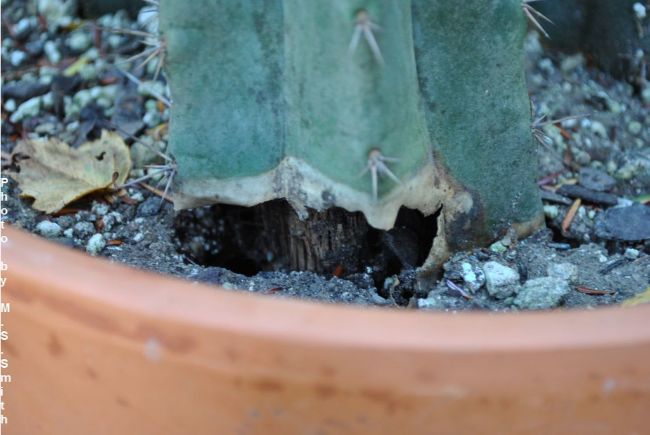
Common Mistakes When Deciding When To Water Cacti
When getting a new Cactus as a house plant, there are a few mistakes that you need to avoid. Below are a few common mistakes that people make when it comes to watering an indoor Cactus:
- Over Watering Or Under Watering
This is usually due to lack of know-how. Knowing what type of Cactus you have will help you to better understand its water requirements. Watering the plant too frequently will lead to root rot while watering too infrequently will result in the plant drying up, puckering and dying. The trick is to get a careful balance.
- Overlooking The Nutritional Needs Of The Cactus
It is a common misconception that a Cactus requires no added fertilizer to thrive. This is probably because the plant is considered hardy and drought resistant.
Adding a bit of diluted fertilizer to your water can be the trick to growing healthy Cacti. Of course, don’t overdo it. Only add diluted liquid fertilizer to your watering can during the growing season and make sure that it is mixed to only a quarter of the recommended strength on the bottle.
Too much fertilizer can burn the plant or result in build-up in the soil which can damage the root system and result in leaves turning brown/yellow and falling off.
- Using The Wrong Container
Cacti need containers with sufficient drainage holes so that no water can trap in the bottom and lead to root rot. While you can plant a Cactus in a container with no drainage holes, you will need to be extra careful with how much and how frequently you water.
The best choice is a container that breathes easily such as a terracotta container. For the ultimate convenience, choose a pot that already has drainage holes that do not become clogged with Cactus mix.
- Using The Wrong Growing Medium
Cacti need growing medium that drains quickly. People often overlook this because they believe that the Cactus is the hardiest plant of all and can grow in almost any conditions.
If you use the incorrect potting soil, you could find your Cactus suffering from root rot. Buy a succulent or Cactus potting mix or make your own for the best results.
- Using The Wrong Water Source
While some tap water sources are just fine, other sources have high quantities of dissolved minerals and chemicals such as fluoride, chlorine and chloramines that can affect the health of your cactus.
If your cactus is struggling and you can’t work out what is wrong, it may be good to try collected rainwater or distilled water to help your cactus thrive.
Last Word
Learning when to water cactus can take a bit of trial and error. Watching the Cactus for signs of distress is an important part of being a Cactus houseplant lover. The most important thing to remember is to monitor your cactus and the potting mix to know when to water a cactus and don’t water on a schedule. Once you develop the techniques to identify when your cactus needs watered, you wont look back and your cacti will be thriving.

